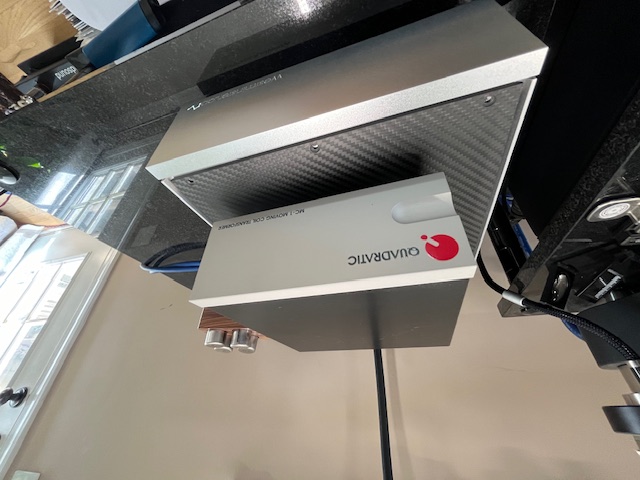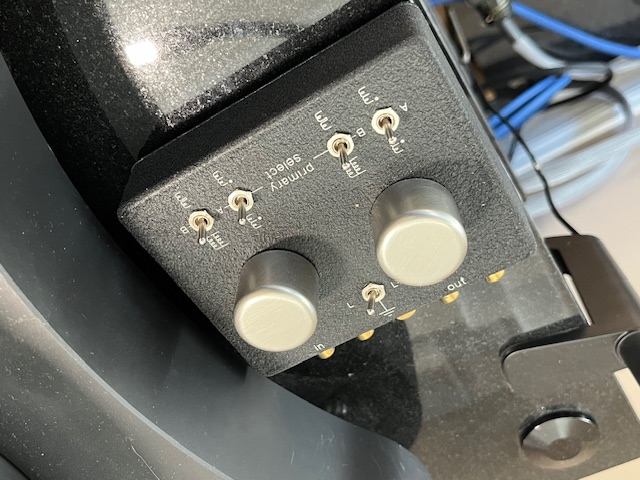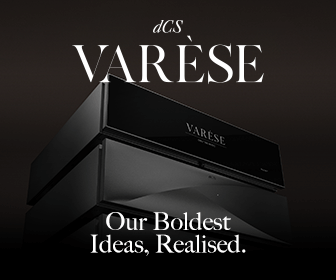Shootout at the SUT Corral.
Dave McNair listens and evaluates four moving coil cartridge step-up transformers.
Dave McNair listens and evaluates four moving coil cartridge step-up transformers.
Once Upon A Time…
…in an audiophile galaxy far, far away, a new species of phono cartridges with high resolution and meager output was discovered. This new life form was known as movere coil, or moving coil to non-Latin speakers.
As a young lad in the mid to late ‘70s, I clearly remember reading about the wonders of MC cart sound, evidenced by H.P. and the rest of The Absolute Sound crew. Maybe there were a few phono stages with enough gain in those days. Still, the generally accepted method for using these early, trend-setting wonders was to use a box containing some amount of active additional gain in front of a standard phono preamp designed for the high output of a moving-magnet-style cart or to rely on the electrical voodoo that happens when a wire-wound magnet is in proximity to another wire-wound magnet.
The input side and the output side are connected with nothing other than air between the two windings. I’ve always been freaked out that current is induced to flow from the input (primary) to the (secondary) output side of the wire-wound magnet. Magic!
If the magnets' flux and number of turns are equal, then it’s known as a 1:1 or isolation transformer, but if the output-connected side has more turns, then the current induced is more than what went into the input side wire-wound magnet.
Passive, noiseless gain from this arrangement is the closest thing in electronics to a free lunch. Thus, the step-up transformer (SUT) was born.
Moving coil carts are more popular than ever in today's audiophile world. This has given rise to most phono stages, whether self-contained in a line preamp/integrated amp or as an outboard phono preamp, including circuitry designed to amplify the itsy-bitsy signal of low-output, moving-coil carts.
Some phono stages use all active gain devices; others use a combo of a self-contained SUT for the first 15 db or so, then hand off to an active gain stage(s).
So, what is the benefit of using an SUT before a lower-gain, moving-magnet phono stage? Is there any benefit? This is precisely what I wanted to find out.

Roll up for the Magical Transformer Tour; Step (up) Right This Way
I want to talk briefly about my experiences over the years using transformers in music production. Almost any experienced recording engineer, mixer, or mastering engineer who uses gear containing transformers knows in their bones that transformers have a sound, and they all sound different.
One famous compressor used in all phases of music production has a toggle-switchable choice of three different output transformers, each using a different metal for the magnetic core. Nickel sounds different than steel or iron. Various types of metallurgy in wire and the wire's gauges contribute to sonic differences. So does the geometry of the winding. Some transformers made in the ‘40s, ‘50s, or ‘60s are particularly revered for their sonics and go for steep prices on the used market. Some pro gear use these in circuits that don’t even require a transformer for proper operation - folks just love that sound.
One interesting side note: there was a period in the ‘70s when everybody pulled out of gear as many transformers as possible —tape decks, consoles, compressors, you name it. They were thought to contribute to the signal undesirable non-linearities and grunge. Doug Sax employed a famously transformerless signal chain at his Los Angeles studio, The Mastering Lab.
During a session I attended, Doug told me that the only things stock in his Teletronix LA-2a vacuum tube/transformer-rich compressors were the optical resistor and the tubes—not a transformer in sight.
That was the analog era. But sonics (like many other things) cannot escape changing styles and tastes.
Now that digital has improved from the early low-rez, plastic sonics, the major fault of current-day SOTA digital technology is that it adds nothing to the microphone signal. Those Blue Note and Shaded Dog RCA records we love have color galore - partly because of all the transformers used in the long-winded signal path of that era.
These days, engineers want to add some mojo or color to the signal due to a very concise analog signal path between the microphone and the end listener.
Would this strategy apply to vinyl playback? This was my mindset going into my SUT listening extravaganza.
What I Tested and My Listening Methodology
The selection of SUTs I got didn’t have much to do with what is currently popular or of a particular price category. I simply got stuff from folks I knew or was introduced to. My goal was not to find the best (which is unknowable for many reasons) but to find what kinds of differences I would hear and how they would compare to using a phono stage designed for low-output cart signals.
The SUTDUT (step-up transformer devices under test) were the following:
Quadratic Audio MC-1 - $1,795
Treehaus Audiolab MC SUT - $3,000
Ampsandsound SUT - price to be announced
A “generic” eBay-sourced SUT, listed at $569.00, was built by Ned Clayton in Salt Lake City, Utah.
While I initially experimented with a Westminster Lab - Monolgue phono pre that I’ll be reviewing, I used the built-in phono section in my VAC Master Preamplifier.
The Monologue has internal dip switches for every conceivable gain, impedance, and capacitance value you’d want for matching a phono preamp to any cartridge. However, I also wanted to compare the SUT/MM input to a dedicated MC input. Using the VAC made the most sense because switching cables and turning a rear panel switch was more straightforward (and rapid) than unplugging an SUT and changing multiple dip switches in the Monologue every time I wanted to compare SUT/MM phono stage to the MC phono stage. Using the separate MM and MC inside the VAC Master Pre also required one less cable run and connectors. This setup more closely approximated what a real user would encounter - plugging the SUT output into a (most likely) internal MM phono input.
I used my TW Acustic - Raven LS fitted with the Raven 10.5” tonearm and my Dynavector XV-1t cartridge. It has a .35 mV output and 24-ohm internal impedance.
Warning: Approaching Technical Landmine Area. Proceed at Your Own Risk.
Earlier, I wrote that current is induced to flow between a transformer's separated, air-gapped windings. This is not the complete story because the voltage is increased due to an impedance change. The input signal is transformed to a different impedance (lower to higher in this case), which allows the receiving gain stage to react as if the voltage had been increased.
All the SUTs I tested had multiple primary to secondary windings ratio choices. The Ampsandsound SUT achieves this with plugin transformer “cans.” I received a cool wooden box with places for the six cans; left and right for the three ratios. This gives the user different options of output impedances to the phono stage resulting in more or less gain. The Ebay SUT had toggle switches and cool diagrams indicating the three ratios available. There is more clarification on the bottom of the box. The Treehaus has three discrete, left and right RCA inputs corresponding to the different ratios, and lastly, the Quadratic offers internal jumpers for two ratios.
However, when comparing the SUTs with a 1:10 ratio option, I noticed that the resulting volume level differed slightly. Even though the ratios were the same, the input impedances seen by the cartridge may have been different.
Higher ratios yield more gain, and the output voltage and impedance of the Dynavector cartridge were such that any ratio past about 1:20 was too much gain based on how low I had to put the VAC Master output volume. I didn’t want to drive the VAC phono input hard enough to compromise its headroom. Being a vacuum tube circuit (while I do not doubt its dynamic capability), I didn’t want anything to influence my listening impressions. Thus, I used the lowest ratio available for each SUT - 1:10 or close to it. A ratio of 1:10 is approximately 22 db of gain added to what the VAC MM gain is spec’d at, which is 44 db. This also made comparing the VAC MC input (at 68 db) close enough to the 66 db MM/SUT combo to be at least Fuji to McIntosh instead of apples to oranges.
Now The Fun Part
First, I enjoyed the sound of all the SUTs but preferred the sound of the Dynavector straight into the VAC MC input. However, take that with a grain of laudanum because this test only had one cartridge and the VAC phono sections. There are too many variables to conclude that any MC phono stage is superior to any MM/SUT combo. Onward.
Of course, I listened to the various SUTs leisurely, but I decided early on to use a few select cuts for serious comparison listening. What I used might surprise you.
While I regularly listen to a great deal of jazz and classical records, my wheelhouse is various subgenres of rock - primarily due to my years of music production. While I’ve recorded and mixed or mastered plenty of jazz projects and even some classical, I have a deeper knowledge of where the “bodies are buried” in non-jazz and classical, so I’ve found I can drill down to the musical gestalt of component differences with more certainty if I use that kind of music. And it doesn't have to be cuts that I’m highly familiar with or have worked on, although I often check those as well.
I used “Runaway” and “Senses Working Overtime” from the XTC masterpiece English Settlement, “Wrapped Around Your Finger” and “Tea In The Sahara” from The Police - Synchronicity, “Leave It Alone” and “Cinnamon” from Hayley Williams - Petals For Armor, and “15 Step” and “Bodysnatchers” off the Radiohead album In Rainbows.
In addition to the TW Acustic/Dynavector/VAC pre, my system has recently evolved to include the end-game Acora Acoustics - VRC loudspeaker, currently driven by Ampsandsound Zion Monos.
Besides being the most satisfying and musical speakers I’ve ever encountered, the VRC is like an electron microscope for hearing upstream component differences, whether readily apparent or highly subtle. And they pull this off when playing music at any volume - from very quiet to very loud. My dream speaker in every way.
 Initially, the sonic differences between the various SUTs seemed relatively minor. But as has happened many times before, minor differences became more pronounced the more I swapped and listened.
Initially, the sonic differences between the various SUTs seemed relatively minor. But as has happened many times before, minor differences became more pronounced the more I swapped and listened.
My early favorite was the Treehaus Audiolab SUT. I’m sure my initial preference had much to do with its oversized, beautiful, handcrafted look. The hardwood base, the copper-wrapped artisanal Japanese transformers, and the engraved etchings that indicate the ratios of the various RCA inputs scream audiophile Nirvana. Oh, and it sounded good, too.
The Treehaus sounds like it looks—sweet and silky-smooth but detail-rich. Musical elements from my selection of test cuts took on a subtle saturation in color. The harmonics and dynamic profile that give a great recording such an enjoyable texture were portrayed by the Treehaus in a mesmerizing way. It simultaneously relaxed and energized vinyl playback.
When I had the Treehaus plugged in, I felt like someone had given me a handmade silk kimono to wear while I listened to records.
In the 150-250hz region, low frequencies took on excellent focus and a pleasant warmth. Nothing seemed gloopy or blown-up-sounding, but the slight additional density to bass and upper-bass frequencies pleased my ear. The top end was airy, extended, and smooth, but a hair emphasized.
The Treehaus was also the most difficult to position for the lowest hum.
Oh yeah, hum. All the SUTs added a small amount of hum. It wasn’t a deal breaker because, through careful positioning, I could get the hum level low enough not to be audible during playback. It turns out that not only position but also the grounding scheme are big things (as is the connecting cable shielding!_ed).
As I like to tell my friends, I’m drawn to vinyl playback mainly because of its high cost and inconvenience.
 If the Treehaus had the most easily detectable sonic signature, the Quadratic Audio MC-1 was the most neutral. It also comes with a well-written manual that explains the operation and principles of SUT use. As with the other SUTs, I tried both its ratios, which are internally selectable using pluggable jumpers.
If the Treehaus had the most easily detectable sonic signature, the Quadratic Audio MC-1 was the most neutral. It also comes with a well-written manual that explains the operation and principles of SUT use. As with the other SUTs, I tried both its ratios, which are internally selectable using pluggable jumpers.
The Quadratic produced the most color-free gain and, of all the SUTs, sounded the closest to using the VAC's dedicated MC input.
There's not much I can say here about the sound. I heard no definitive sonic signature, and it never got in the way of enjoying whatever cut I played. If you had told me it was a box of very clean active gain circuits, I wouldn't have guessed it was a transformer—this level of transparency results from outstanding engineering by the Quadratic team.
If you love the sound of your cart and the rest of your system yet have a nagging suspicion that your MC phono stage is less than great, kinda noisy, and is the weak link, a Quadratic MC-1 into an MM input could be just the ticket.
 Next up, the Ampsandsound SUT. As a practical artisan, Justin Weber applied his plugin transformer can concept (which he uses in his latest series of preamplifiers) to a standalone SUT box. I received an attractive wood box to house the six cans (three different ratios) and was told by Justin that a customer could custom order any ratio for his or her cartridge. My higher output and higher internal impedance Dynavector was fine for comparison purposes. Still, MC carts with much lower output voltage and impedance benefit more from a well-matched SUT.
Next up, the Ampsandsound SUT. As a practical artisan, Justin Weber applied his plugin transformer can concept (which he uses in his latest series of preamplifiers) to a standalone SUT box. I received an attractive wood box to house the six cans (three different ratios) and was told by Justin that a customer could custom order any ratio for his or her cartridge. My higher output and higher internal impedance Dynavector was fine for comparison purposes. Still, MC carts with much lower output voltage and impedance benefit more from a well-matched SUT.
The Ampsandsound box fitted with a pair of 1:10 cans was more neutral than the Treehaus but less than the Quadratic. It has a very pleasing density in the midrange. The bass was solid and not particularly slanted one way or the other. The highs seemed to have a very gentle roll-off that didn't make the sound dark, but didn’t quite have the extra excitement of the Treehaus nor the flatness of the Quadratic. I’m talking tiny degrees here. Overall the Ampsand sound SUT was an easy-to-use, very enjoyable listen.
 The eBay-sourced SUT by Mr. Ned Clayton was the dark horse that did not disappoint. It was the Goldlocks in my SUT comparison.
The eBay-sourced SUT by Mr. Ned Clayton was the dark horse that did not disappoint. It was the Goldlocks in my SUT comparison.
It didn’t have enough of an overt texture to put a finger(ear?) on, but it was not as colorless as the Quadratic. There was nothing flashy about its presentation, but at a very reasonable price of $569, it more than held its own against the other challengers. It was neither bland nor dazzling, but it got the job done, and I was more than happy to listen to lots of records with this “Salt Lake City, everybody off” SUT. Thanks, Jonathan Richman.
Another thing happened in my SUT extravaganza: one final SUT and a companion cartridge arrived late in the game. A Lyra Etna SL and Lyra Erodion EVO SUT.
I dutifully fitted the Etna on my TW arm and meticulously used Wally Tools et al. to achieve a solid alignment. However, I couldn't get it to sound as good as I knew it should. Shane Buettner, the USA Lyra importer, told me it was a demo cart that had made lots of rounds, so he was going to send it back to Lyra for a look-see.
Even as the Etna sounded dynamically lifeless, a bit too bright, and generally not an engaging listen, I figured that I could at least glean more info using the Erodion EVO SUT on my Dyna cart.
I could tell that the Erodion EVO had a very classy-sounding heart, but it didn’t give the Dyna its proper tonal balance. Hmmm. But wait, later I was informed that an Erodion EVO SUT is not intended to be used on anything other than Lyra MC carts, so this explains the tonal shift since my XV-1t is nowhere near the internal impedance and output of the Lyra carts.
It was a bummer that this particular Etna had problems for unknown reasons—I mean, c’mon, it had no family resemblance to the Lyra Atlas I used in my Oracle review a few months back. Plus, no one would describe a properly working Lyra cart of any model as sounding like this, so it had to be broken. And the Lyra Erodion EVO SUT is designed to work with the Lyra's low output and low internal impedance and not my Dynavector, so the Lyra portion of my testing was a wash.
So What Did I Learn?
Quite a few things.
An SUT is a valid way to get the most from an MC cart, provided you have a solid-performing MM phono stage and either do enough research to sample likely matches for your cartridge’s electrical characteristics or are willing to buy and try.
The other way is to buy an SUT made to mate with a particular cart(s), like the Erodion. If I were a betting man, I’d wager that an Erodion and a Lyra cart into a decent MM preamp stand a good chance of besting most MC phono gain stages with a Lyra straight in.
Furthermore, the slight flavor of most SUTs can be a fun way to add salt and pepper to achieve performance goals that might be on your sonic wish list.
I also learned that although three of the four SUTs used Cinemag transformers, all three sounded different. This should hint at the complexity of getting the SUT that works best for individual tastes and carts. I can also attest to the subtle differences—but only for my cart, phono stage, and the four tested SUTs. In a different situation, I can imagine very different-sounding results.
Interestingly, I heard little or no difference in imaging characteristics between the various SUTs.
I also learned that price and performance may not directly correlate in the SUT world.
This is sometimes the case for any hifi component, but generally, I’ve found that the high-priced stuff does sound better. Shopping for the perfect SUT for your system could be a great way to find your personal “giant killer.”
So go forth and step up your cartridge game - the fun awaits.













































